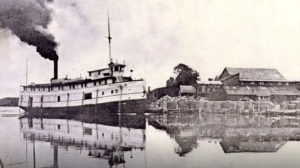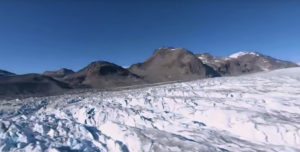Great Lakes Now wants to help your students explore the Great Lakes.
That’s why we’ve designed a collection of lesson plans that engage students with the science and study of the Great Lakes. Designed for middle school classrooms, these lessons will help students to become familiar with geologic, geographic, and environmental concepts about the Great Lakes, as well as provide them the opportunity to evaluate contemporary issues facing the lakes.
The collection is divided into two sets, the first of which addresses the structure, function and formation of the Great Lakes and the second of which focuses on the threats to the ecosystems from pollution, invasive species and climate change. Each lesson includes a student-centered learning framework and activities to help students experience, participate, and connect with the learning. Plus there’s a “virtual field trip” with videos exploring coastal wetlands.
Collection 1: An Exploration of the Great Lakes
Collection 2: An Exploration of THREATS to the Great Lakes
Collection 3: Virtual Field Trip
An Exploration of the Great Lakes Lesson Plan Collection
FOR GRADES 5-8
Great Lakes Now: An Exploration of the Great Lakes is an introduction to the science and study of the Great Lakes. This collection aims to introduce students to basic scientific and geographic concepts about the Great Lakes.
There are 17 lessons in this collection, each aligned to the Next Generation Science Standards and either Common Core standards, Earth Science or SEP standards. The lessons feature a number of interactive or hands-on activities for students to explore such topics as the physical features of the Great Lakes, the interconnectedness of the water system, and the geology and formation of the Great Lakes. Moving away from these majestic lakes themselves, the lessons also explore broader concepts such as watersheds and ancillary bodies of water that are part of the Great Lakes ecosystem, special environments within the Great Lakes region, and examine societal concerns about drinking water quality – both in the lakes and delivered through municipal water systems.
The 17 lessons from this collection can be taught individually or sequenced together as a larger unit on the Great Lakes. Embedded throughout the collection are links to videos produced by Detroit Public Television and Great Lakes Now, as well as a range of other resources that support citizen science and encourage exploration.
View collection here >
Download the collection >

Lesson Plan 1: Meet the Great Lakes
In this lesson, students will be introduced to physical and geographic features of the Great Lakes, including the size, area, amount of water, and locations of each, as well as the significance of the Great Lakes to many aspects of life for the region in which they are located. View >

Lesson Plan 2: H.O.M.E.S. for Sale
In this lesson, students deepen their knowledge of physical and geographic features of the Great Lakes by exploring one of the five Great Lakes in depth with a study group and creating a “for sale sign” poster to present to the class for one of the Great Lakes. View >

Lesson Plan 3: Lakes Levels over the Years
In this lesson, students will analyze historic lake level patterns of the Great Lakes to learn about one measure of lake health—the level—and how data is monitored over time for a lake. View >

Photo Credit: Brian Cluer, NOAA Fisheries West Coast Region, California Coastal Office
Lesson Plan 4: The Great Lakes Watershed
In this lesson, students will model how a watershed works to understand how the Great Lakes basin is a large watershed region. View >

Lesson Plan 5: A Digital Expedition around the Great Lakes
In this lesson, students will act as digital explorers traveling through the Great Lakes using an interactive digital atlas to learn about the interconnectedness of the Great Lakes waterways. View >

Lesson Plan 6: Water beyond the Lakes
In this lesson, students will investigate various features of the Great Lakes basin, including an exploration of groundwater, ancillary bodies of water—such as estuaries, rivers, falls and locks—and how ice cover in winter affects the Great Lakes. View >

Lesson Plan 7: Great Lakes Ecosystems
In this lesson, students will investigate various environments of the Great Lakes, including an exploration of flora and fauna unique to the region. View >

Lesson Plan 8: Great Lakes Regional Meteorology
In this lesson, students will become familiar with some of the unique meteorology of the Great Lakes region in terms of weather and climate. View >

Lesson Plan 9: [Debate]: Which of the Five Great Lakes Is Best?
In this lesson, students will synthesize learning about the five Great Lakes and apply their knowledge to engage in a debate about which of the Great Lakes is the best lake. View >

Lesson Plan 10: Loading…4.54 Billion Years
In this lesson, students will be introduced to the geologic time scale and a brief history of geologic time. View >

Lesson Plan 11: All about Glaciers
In this lesson, students will become familiar with glaciers, how they form, move, and shape the land. View >

Lesson Plan 12: Formation of the Great Lakes
In this lesson, students will understand the particular impact that glaciers had in forming the Great Lakes by carving out the basin and filling the waterways with ice melt as they retreated over 10,000 years ago. View >

Lesson Plan 13: Historic Significance of the Lakes
In this lesson, students will be introduced to the ways in which people encounter the Great Lakes as they explore some of the history of the Great Lakes, including how local people groups regard the waters, how New World explorers from Europe traveled the Great Lakes waterways, and how the Great Lakes are a source of commercial transport. View >

Lesson Plan 14: How Fresh are the Great Lakes?
In this lesson, students will continue examining the historic significance of the Great Lakes by focusing on one of the key ways that people encounter the Great Lakes—as a source of freshwater. View >

Lesson Plan 15: Travel & Leisure on the Great Lakes
In this lesson, students will interact with the ways that people encounter the Great Lakes through travel and leisure activities. View >

Lesson Plan 16: Economic Significance of the Great Lakes
In this lesson, students will be introduced to one of the main ways that the Great Lakes impact the economy of the region—shipping. View >

Lesson Plan 17: Contemporary Issues Facing the Great Lakes
In this lesson, students will explore several contemporary issues facing the Great Lakes, including naturally occurring phenomena, such as invasive species, and issues that arise as a result of human activity, such as chemical pollutants. View >
An Exploration of THREATS to the Great Lakes Lesson Plan Collection
FOR GRADES 5-8
Great Lakes Now: An Exploration of Threats to the Great Lakes is an introduction to the natural threats to and human impact upon, the Great Lakes. This collection of lessons — the second volume — aims to build on prior knowledge introduced to students in the first volume pertaining to basic scientific and geographic concepts about the Great Lakes but focusing how manmade and naturally occurring conditions threaten aspects of the world’s largest supply of surface freshwater.
There are 11 lessons in this collection, each aligned to the Next Generation Science Standards and either Common Core standards, Earth Science or SEP standards. The lessons feature a number of interactive and hands-on activities for students to explore topics ranging from invasive species and algae to climate change and pollution. Beyond the specific look at some of the harm to the Great Lakes environment, this lesson collection gives special attention to potential solutions to the problems threatening the Great Lakes and explores some of the restorative measures being taken on some of the issues. Through the activities and lessons, students are introduced to ways that they can adjust their own behavior, or raise the awareness of those around them in their lives, to positively impact the Great Lakes and work to mitigate the effects of some of the threats.
The 11 lessons from this collection can be taught individually or sequenced together as a larger unit on modern threats facing the Great Lakes. Embedded throughout the collection are links to videos produced by Detroit Public Television and Great Lakes Now, as well as a range of other resources from PBS that support citizen science and encourage exploration.
Download the collection >

Photo credit: Dusty Klifman
Lesson Plan 1: Dear Great Lakes
Students will be introduced to the threat of coastal flooding that faces the Great Lakes and many other coastal areas in the world due to climate change. View >

Lesson Plan 2: What’s Greenland Got to Do With the Great Lakes?
Students deepen their knowledge of the impact that climate change and rising water levels can have on the Great Lakes. The focus here is to connect melting glaciers and sea level rise to the volume of water in the Great Lakes. View >

Lesson Plan 3: Fish Population Dynamics
Students will model how the population of two freshwater fish species change over time and depend on one another. View >

Photo provided by James Proffitt
Lesson Plan 4: Does Fishing Threaten the Great Lakes?
Students will understand the link between fish population dynamics and the fishing industry. There is a mutual relationship between the two, which students should realize by the end of the lesson, because humans and fish are part of a common food chain in the Great Lakes. View >

Lesson Plan 5: Lake Invaders
Students will examine one of the most notable invasive species threatening the Great Lakes—the Asian Carp—and explore some of the solutions that are being tried to deal with the invasive species around the lakes. They will learn about the invasive species through several short videos and then integrate their knowledge by creating an infographic about the threat posed to the Great Lakes by the Asian Carp. View >

Lesson Plan 6: The Bloomin’ Algae Harming Lake Erie
Students will learn about the nitrogen and phosphorus cycles and investigate how these nutrients are cycled through the ecosystem near Toledo, OH, eventually causing significant algal blooms that threaten the water supply along the western coastline of Lake Erie. View >

Lesson Plan 7: A Freshwater Oil Spill Cleanup Simulation
Students will learn about a remote Canadian research station where scientists are working to understand the effects of oil spill pollution on freshwater and simulate an oil spill cleanup effort in the lab. View >

Lesson Plan 8: Restoring Rivers of the Great Lakes
Students will become familiar with two major river projects, one in the Chicago River and the other on the Cuyahoga River, and the restoration efforts involved with each. View >

Lesson Plan 9: Responding to the PFAS Crisis
Students will learn about per- and poly-fluoroalkyl substances (PFAS) and synthesize their learning into curious questions, as well as evidence-based responses, about the chemical that is threatening the Great Lakes. View >

Lesson Plan 10: The Supply and Demand of Groundwater
Students will investigate solutions to groundwater shortage and be introduced to the story of Ottawa County, MI where a water shortage caused such water scarcity that taps ran dry for residents. View >

Lesson Plan 11: Fatberg, Right Ahead!
Students will become familiar with fatbergs, how they form, move, and affect the sewer systems of municipalities. View >


